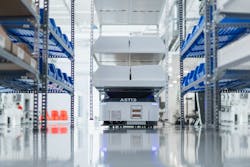E-commerce is quickly becoming the preferred way to purchase merchandise as products can be conveniently picked up at the store or delivered directly to the buyer’s doorstep. As more consumers buy products online, CPG manufacturers are forced to change the way they interact with the entire supply chain.
According to Bart van Dijk, a partner at management consulting firm Kearney, the need to recalibrate the supply chain as the direct-to-consumer model grows to mass scale requires new kinds of platforms and partnerships. To that end, key priorities moving forward include an efficient and responsive last mile and anticipating recycling, refurbishment, and return flows. That means maximizing the use of technology and automation to gain more flexibility and agility.
“CPGs are already anticipating this by building plug-and-play capabilities and creating an ecosystem with suppliers that creates a sense-and-pivot capability, sensing what is going on upstream and downstream in the supply chain to pivot where they need to,” said van Dijk, who is a core member of Kearney’s operations and performance practice.
This observation, made during a recent ABB webcast, provided a big-picture view of how e-commerce and the omnichannel is impacting the current state of the supply chain. It was also meant to help position ABB’s latest acquisition.
In July, ABB announced the acquisition of ASTI Mobile Robotics Group, a global provider of autonomous mobile robot (AMR) vehicles and software. ASTI, based in Burgos, Spain, adds to ABB’s robotics and machine automation product portfolio.
“With this acquisition, ABB will be the only company to offer a full automation portfolio of AMRs, robots, and machine automation solutions, from production to logistics to point of consumption,” said Sami Atiya, president of ABB’s Robotics & Discrete Automation business, in a statement. “This is a gamechanger for our customers as they adapt to the individualized consumer and seize opportunities presented by significant changes in consumer demand.”
ASTI’s AMR portfolio includes autonomous towing vehicles, goods-to-person solutions, unit carriers and box movers, as well as comprehensive software offerings ranging from vehicle navigation and control, fleet and order management, and cloud-based traceability systems. These will be integrated with ABB’s robots, B&R machine automation, and the software suite including RobotStudio, ABB Robotics’ simulation and programming tool.
“Stationary robots do palletizing, depalletizing, and sorting, but intelligent material flow is needed and that can’t happen with just conveyors,” said Marc Segura, managing director for ABB’s robotics consumer segments and service, during the ABB webcast. “You need AMRs. And to bring this together in a real-time operation, you need fleet management software to orchestrate things. This is a unique portfolio we assembled to address the new challenge in the industry.”
The new challenge being omnichannel fulfillment. To that end, at PACK EXPO Las Vegas 2021 in September, ABB demonstrated its technologies for automated omnichannel fulfillment that enable manufacturers to handle small, personalized batch orders in a direct-to-consumer model—something that is difficult for traditional warehouse distribution centers to manage. For its part, ABB brings together delta robots, collaborative robots, the B&R AcoposTrak flexible transport system, lane changing conveyors, palletizing robots, and AMRs.
“The AMR plays an important role in flexibility as different processes are automated through the AMR from the receiving of goods to the production line to the warehouses, with constant traceability to secure where the loads are located,” said ASTI CEO Veronica Pascual Boé. “The flexible automation concept is having a multiplier effect through the industrial and mobile robot combination. We are providing technology that is able to be redeployed in a scalable manner to support the new evolution of customer demands.”
ABB may have solved the manufacturing and warehouse part of the omnichannel with its latest acquisition. But in order to use logistics as a competitive advantage, Kearney’s van Dijk reiterates that the sense-and-pivot model is important. And that might mean changing the network model all together. Perhaps sourcing raw materials from supply partners that are logistically closer to the manufacturing facility. “Look at the big picture and longer term trends. There could be new pandemics, so know what’s going on and what the consequences are in the supply chain,” he said.
Leaders relevant to this article:

